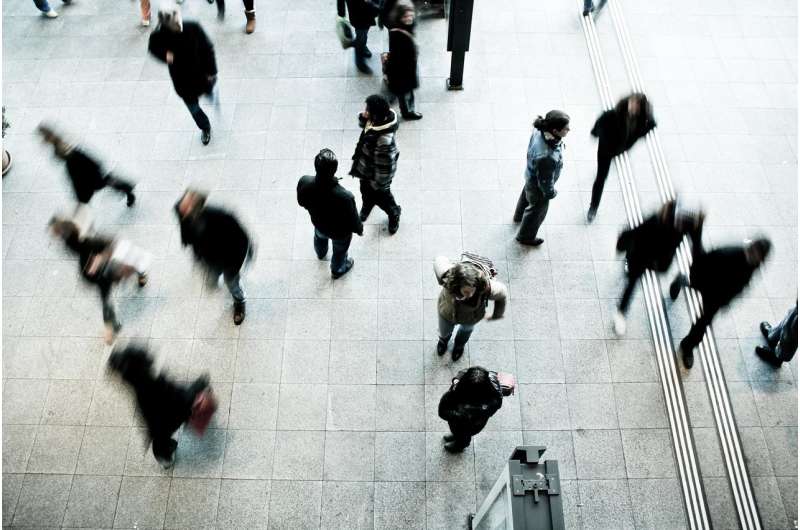Pedestrians keep a 75 cm comfort zone to prevent collisions

Pedestrians are constantly avoiding collisions with oncoming people. Meters in advance they unconsciously change their walkway to pass each other. Physicists at Eindhoven University of Technology in collaboration with American and Italian researchers analyzed 5 million pedestrian movements at the Eindhoven train station. They discovered that people want to keep an average distance of at least 75 cm. Professor Federico Toschi and postdoc Alessandro Corbetta publish these results today in the journal Physical Review E.
From all the data taken, about 9,000 pedestrian pairs turned out to be on a course towards each other, with the risk of a collision. Corbetta: "About 40 pairs of these actually bumped into each other. The remaining pairs adapted their walkways until they were at least 140 cm apart and were therefore able to prevent a collision."
Using this 'big data,' the researchers developed a model that can statistically predict pedestrian movements very accurately. This allows one to know in advance how many pedestrians, for example, of a group of 1000 people, will run, walk, dodge, turn around or collide in a defined area such as a corridor or tunnel.
Two social forces prevent collisions
Corbetta: "To build our model, we found two 'social interaction forces' that play a role: a long-distance force based on vision and a short distance force for preventing hard contacts. As an effect of these forces, people modify their current paths to prevent collisions."
With this research, Toschi and Corbetta are trying to push the application areas of fluid dynamics even further. Fluid dynamics not only encompasses the movement of gas particles in a room, water in the sea, or grains in an hourglass: they also include the dynamics of active flowing matter, such as flocks of birds, fishes in a shoal or pedestrians in a crowd. Physics and fluid dynamics can help us with understanding the flow of these less-traditional systems and, at the same time, the study of active flowing matter brings new challenges that can shed new light on established approaches.
The research in this study builds on their previously developed model of a few people walking along a corridor.
Toschi: "In 2014 we monitored a corridor to the canteen of the Metaforum building on the TU/e campus for about 12 months. The two social forces that we see in the current research at Eindhoven train station were successfully incorporated into the earlier model. In this way, we slowly extend the simplest model to predict pedestrian movements."
Both studies show that statistically speaking, there seems to exist robust universal features of crowd flow, independent from the specific setting. "We saw in our data that about one in 1000 people would stop and invert their trajectories, to exit the tunnel or corridor from the same side as they entered it. Even though they were walking alone and regardless of the motivation. We measured this both at the train station and on campus. Performing real-life experiments is therefore critical to push our understanding. You would never have measured these features in a lab experiment where participants are instructed to execute actions," Toschi explains.
Same sensors as game console bar
For their research, Toschi and Corbetta installed 4 overhead sensors at the front of the underpass of Eindhoven station. For six months (between September 2014 and April 2015) they observed all pedestrians within a zone of 3m x 9m. The sensors use an infrared laser illuminator to construct a black and white "depth image" of the scene. In a depth image, pedestrian heads, which are closest to the sensor, result in a dark grey spot, while shoulders, which are slightly further away, appear in lighter shade. This allowed the researchers, thanks to algorithms developed in house, to localize and track all the individual pedestrians and their speed.
Corbetta: "Our sensors work the same way as game consoles that register motion with a bar above your TV. These sensors come with strong advantages: they work well even in the dark, and they do not compromise one's privacy. The data acquired involves only depth values represented in grey shades."
Steer pedestrians unconsciously
For Toschi and Corbetta this research activity is far from being concluded. "I always try to go a step further in the complexity of pedestrian movements. I dream of eventually understanding the dynamics of a whole dense crowd," says Toschi, "We are now working to evaluate the results from our experiment at Glow 2017, called 'Moving lights.' There, together with the Intelligent Lighting Institute (ILI) and Philips Lighting, we looked at whether we could direct people by means of light. We let pedestrians choose to leave our exhibit through the left or the right exit. Using light with different intensity levels, we aimed at altering routing decisions in favor of one of the two exits. The first results now indicate that it does indeed appear to be possible to steer people.
We also set up an experiment in the Naturalis museum in Leiden, where we are investigating the behavior of school children who all have to walk through one entrance gate. We aim at publishing both results soon."
More information: Alessandro Corbetta et al. Physics-based modeling and data representation of pairwise interactions among pedestrians, Physical Review E (2018). DOI: 10.1103/PhysRevE.98.062310
A. Corbetta, C. Lee, R. Benzi, A. Muntean, F. Toschi. Fluctuations around mean walking behaviours in diluted pedestrian flows. Phys. Rev. E. 95, 032316, 2017
A. Corbetta et al. A large-scale real-life crowd steering experiment via arrow-like stimuli. To appear: Pedestrian and Evacuation Dynamics 2018, arXiv:1806.09801 [physics.soc-ph], arXiv:arxiv.org/abs/1806.09801, 2018
Journal information: Physical Review E
Provided by Eindhoven University of Technology



















